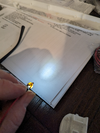JNordgren42
Sr Member
I'm planning a build of the 1/350 Polar Lights Refit Enterprise and I'd love to hear any direct experience you have with the various upgrade options. I want to build it with the TMP iridescent aztec paint scheme. There are a few that I'm pretty set on, first the Green Strawberry bridge and officer's lounge resin upgrade sets. I want to have a go at my own lighting rig based on an Arduino board for control, so I don't really need lighting kit options. What I would like to hear about are the following:
Aztec mask sets: Orbital Drydock vs. Aztec Dummy. And are there any other good options for the full 5 color aztec pattern?
Main PE upgrade sets: Paragrafix vs. Green Strawberry?
Is the Green Strawberry resin impulse engine set worth it?
I also have a resin 3D printer, so I'm open to any STL files that anyone has had good experience with.
Finally, the consensus seems to be that an internal armature isn't needed for the refit, but I'd like to hear how models are fairing years down the line.
I appreciate any input anyone has to offer. This is a big kit and a major project and I want to do it right.
Aztec mask sets: Orbital Drydock vs. Aztec Dummy. And are there any other good options for the full 5 color aztec pattern?
Main PE upgrade sets: Paragrafix vs. Green Strawberry?
Is the Green Strawberry resin impulse engine set worth it?
I also have a resin 3D printer, so I'm open to any STL files that anyone has had good experience with.
Finally, the consensus seems to be that an internal armature isn't needed for the refit, but I'd like to hear how models are fairing years down the line.
I appreciate any input anyone has to offer. This is a big kit and a major project and I want to do it right.


